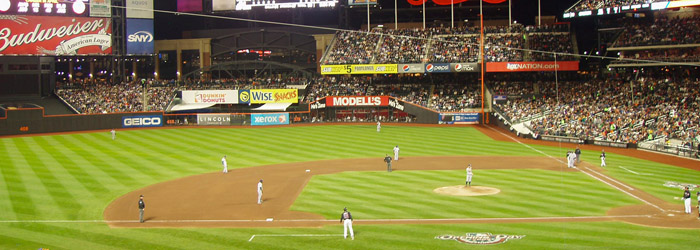


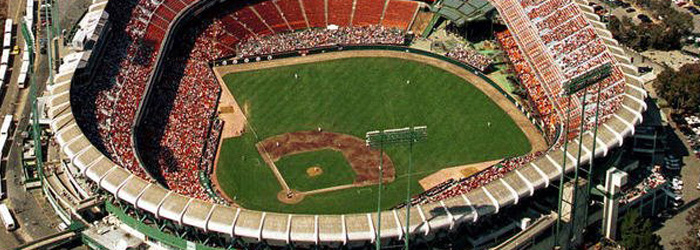
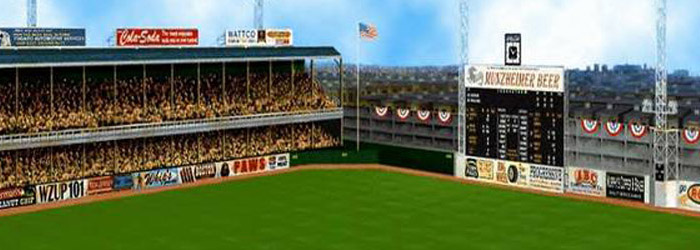
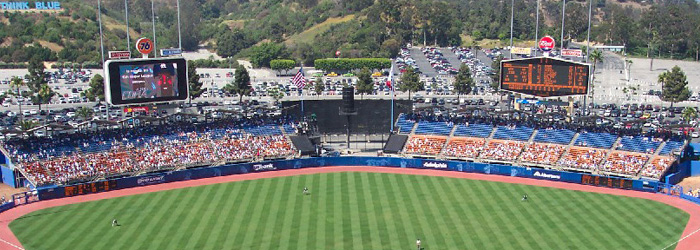
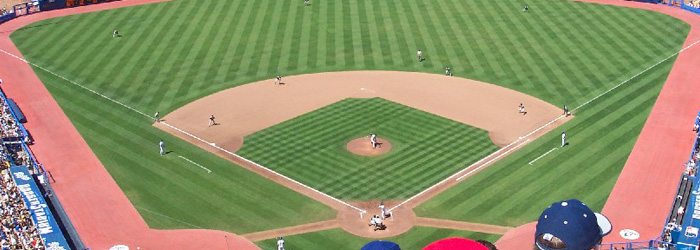
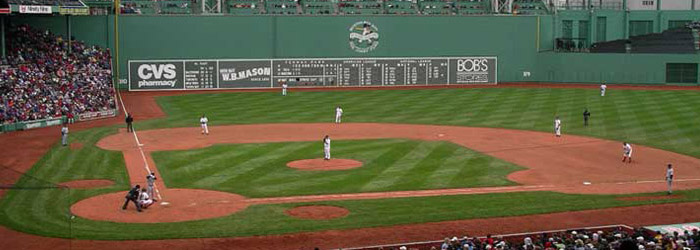


In a 1956 spring training survey, Elmer A. Blasco, employed by Rawlings Sporting Goods as an advertising, public relations, and sales manager, found that 83 percent of the active regular major league players wore Rawlings gloves or mitts. Noting that Hillerich & Bradsby (the major leagues' leading baseball bat supplier) awarded Silver Bats to the leagues' top hitters, Blasco suggested that Rawlings sponsor a fielding award. After his idea was accepted by Rawlings' management, Blasco contacted the Brown Shoe Company of St. Louis and obtained a hide of gold lame-tanned leather used to make ladies' formal slippers. A glove was crafted from this hide, laced and stamped as a regular fielder's glove, and attached to a metal fixture on a walnut base with an appropriately engraved plate. The Gold Glove Award was born.
The October 2, 1957, edition of The Sporting News featured a full-page advertisement that announced, "Recognizing the importance of superior individual fielding performance to the advancement of baseball as America's national game, Rawlings (Sporting Goods Company) has established Annual Gold Glove Awards beginning with the 1957 season.
"Each of the nine major league players chosen for The Sporting News All-Star Fielding Team will be honored with a Rawlings Gold Glove Award. Selections will be made by a Committee named by The Sporting News. Awards will be Rawlings custom-built gloves or mitts handcrafted of special metallic gold-finished leather, each mounted on a suitable hardwood stand bearing an engraved plate."
The Sporting News publisher J. G. Taylor Spink appointed 19 noted sportswriters for the selection task. They included Shirley Povich, Edgar Munzel, Hy Hurwitz, Earl Lawson, Bob Broeg, Allen Lewis, and Hal Lebowitz. A contest to predict the winners, open to baseball- playing youngsters, was sponsored by Rawlings.
The first Gold Glove winners were announced with great pomp and circumstance in the December 18, 1957, issue of The Sporting News. "Too long neglected, the magicians of the defense have had no real recognition," the article explained, adding that the selections were made "solely on the basis of their defensive ability."
Rawlings and The Sporting News also joined forces that year in the establishment of the Silver Glove Award, given to the top minor league fielder at each position, based entirely on fielding averages.
In 1958 the Gold Glove selection privilege was turned over to the major league players, and an All-Star Fielding Team was selected for each league (as it still is).
In 1961 the method for selecting outfielders was changed. Rather than choosing a left, center, and right fielder for each league, each voter was instructed to name three outfielders regardless of their positions (still the practice today).
In 1965 the managers and coaches of each team took over the voting responsibility, which they have retained ever since. Voters are not permitted to select players on their own teams. In 1987, 139 different managers and coaches took part in the balloting.
Perhaps because of its originality, the Gold Glove is the one Sporting News award that has gained universal acceptance and prestige in the baseball world. However, as with any award, the selections often draw criticism. One common complaint is that too much importance is given to fielding average. Most fans realize that fielding average is not always a reliable indicator of defensive ability, but how much does it influence the Gold Glove voters?
Of the 366 fielding average leaders at the various positions between 1957 and 1987 (discounting pitchers and counting only one outfielder per league each year), 118 (32 percent) also won their respective Gold Glove Awards. We can say, then, that if a player leads his league in fielding average, he has about a one-in-three chance of winning the Gold Glove-not an overwhelming correlation, but about four times better than random chance.
This raises some interesting questions. Since official fielding statistics are not published until months after Gold Gloves are voted on, any voter relying on fielding statistics would probably have to consult (or remember) the previous year's data. Therefore, if fielding average itself impresses voters, we should expect to see many players winning a Gold Glove the year after they lead in fielding average. But it doesn't work out that way. The percentage here is 25 percent or one-in-four-again, considerably better than chance, but less of a factor than leading in fielding averages in the current year.
What about the influence of Gold Gloves on fielding averages? Is an official scorer less likely to charge an error against a player simply because he won a Gold Glove the previous year? Apparently not. Only 23 percent of Gold Glove recipients led in fielding average the following year.
"It is my belief that a lot more is considered than fielding percentage," The Sporting News editor Tom Barnidge says, citing "range, throwing arm, the headiness of the ballplayer." Cincinnati's Pete Rose, a two-time Gold Glove winner, agrees: "There are a lot of intangibles involved in voting for the Gold Glove. Take an outfielder. The coaches and managers watch these guys all the time. How they play the hitters, how strong their arms are, how often they hit the cutoff man, and all that is taken into consideration-things that do not show up in the statistics."
Another criticism of the Gold Glove arises because batting performance plays a role in the selections, contrary to the award's philosophy. As USA Today baseball editor Hal Bodley puts it, "A player who is outstanding on defense and respectable on offense has a much better chance of getting a Gold Glove than a counterpart whose forte is fielding alone."
Other factors can be distractions to the voters: flashiness, reputation, and the selection process itself. Wes Parker, a six-time winner of the Gold Glove at first base, grabbed the honor from a seven-time winner, and Parker won it even though he batted as low as .239. He became one of only two nonpitchers (Roberto Clemente is the other) to win the award in his final major league season. "I would say many, if not most, coaches and managers fail to take their voting responsibility seriously," Parker says. "They don't treat it as a vital act. They are usually much more concerned with their team and the pennant race and, as a result, tend to zip through the ballots (distributed in September). So they wind up voting for the most recognizable names."
Parker brings up another rarely discussed procedural problem: "Since players (when they were voting) and coaches are forbidden to vote for anyone on their own team, they often won't vote for the guy who is contending with their team's leading candidate for the same award. That increases their teammate's chances." Parker asserts that reputation "has a lot to do with it, absolutely. In 1966 Bill White won the award (for the seventh consecutive time), although even White admitted that I probably deserved it. It takes a couple of years for your reputation to catch up with you, but that can work to your advantage at the end of your career.
"Flashiness is a factor too," Parker says. "It puts the player's name in the forefront of the voters' minds." He also concurred with the theory that a player's bat can be the difference in winning this fielding award. Four-time Gold Glove winner Steve Garvey is a good example of someone who won it with his bat and notoriety, "a perfect example, in fact," says Parker. "Garvey was vastly overrated defensively…he had no range, no arm, and no aggressiveness. He would hold the ball and allow opposing runners to take extra bases to avoid throwing errors. That's how he compiled his high averages at first base. Remember, he was a terrible third baseman, worst I ever saw." (In 1972, Garvey's last season as a third-sacker, he led the NL with 28 errors in only 85 games, posting a woeful .902 percentage.)
"Amazingly, despite these prejudices," Parker says, "I think the Gold Glove choices have been excellent. At first base I think they have been perfect, with the exception of Garvey."